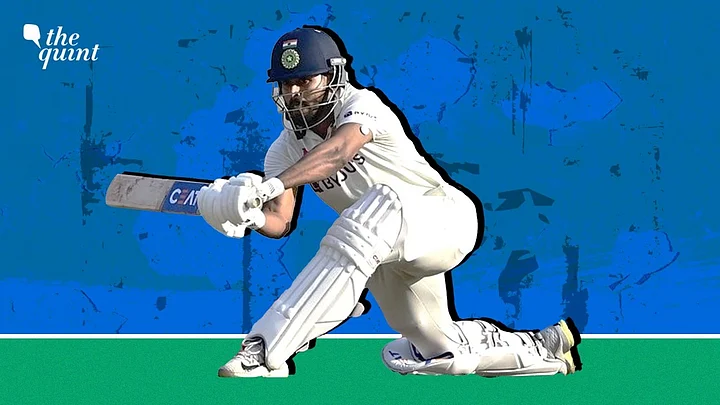If ‘precarious’ could ever be a bovine understatement of a situation, perhaps an attempted euphemism, it was the situation India were in, when Shreyas Iyer came out to bat on Christmas Day. For him, and for India, things were far from ‘merry’, with the team was reeling at 71/6 in the second Test against Bangladesh.
One might have misapprehended the pitch at Mirpur’s Shere Bangla National Cricket Stadium for a stolen audio mixer among the millions at work on Christmas parties, as everything that was fed to it, spun like a top.
The target of 145 looked far, and a place in the final of the ICC 2021-22 World Test Championship, even father. Mehidy Hasan Miraz had just completed his four-wicket haul by dismissing an in-form Rishabh Pant, and for Bangladesh, celebrations seemed to have started sooner than expected.
But then came Shreyas Iyer.
He had just played three deliveries that Miraz completed his fifer – Axar Patel being his latest prey. If 71/6 still inspired hope in the staunchest of optimists, 74/7 certainly ensured only one plausible outcome – agony.
Giving him company from the other end was Ravichandran Ashwin – the man with all the experience in the world, but nearly not enough Test runs to make the Indian fans confident. The duo tiptoed cautiously to take India to 89/7, before Iyer decided to call for the shots.
The batter came dancing down the track to hit a delightful square drive off Miraz’s bowling. Three overs later, he struck two more boundaries – this time off the opposition’s skipper, Shakib Al Hasan.
The stage was set. The comeback had started. And even before Bangladesh could comprehend the severity of the situation, the match was taken out of their grasp. The scorecard will state 42 of the match-winning 71-run partnership was scored by Ashwin, but crucially, 22 of the first 32 runs came from Iyer’s bat.
A WTC final against Australia now seems more of a certainty than ever before, as India produced a memorable conclusion to what was a tumultuous 2022.
But when the year will be reviewed, perhaps Iyer’s 29 will not receive the much-deserved veneration.
Virat Kohli’s unbeaten 82 against Pakistan in the ICC Men’s T20 World Cup 2022 will be celebrated – and rightfully so, for it was the knock of a lifetime that only he could have been audacious enough to play.
Rishabh Pant’s unbeaten 125 against England will be celebrated, and so will be Suryakumar Yadav’s unbeaten 111 against New Zealand. Be it Ishan Kishan’s double century against Bangladesh, or Ravindra Jadeja’s 175* against Sri Lanka – clippings of those knocks will make rounds on the internet, and continue receiving applause.
Yet, amid instantaneous euphoria, sustained success might run the risk of being overlooked. Among the plethora of big names, topping the run-scoring charts for India happens to be a player whose position never really looks set in stone – Shreyas Iyer.
The 28-year-old scored 1609 in this calendar year, being the leading Indian run-scorer in men's cricket. Beyond the overall accumulation, what makes Iyer a prized asset is his versatility – he has done well in all formats.
With 724 runs, he was the men in blue’s highest run-getter in ODI cricket this year. Indeed, he was among the mainstays in this format owing to the T20 World Cup preparations making the team management rest the big guns in fifty-over cricket.
But merely using that narrative to play down Iyer’s numbers will be a misapprehension of his potential. With 422 runs, Iyer was India’s second-highest run-scorer in Test cricket this year, albeit having played a match less than Kohli, and a couple of innings less than Cheteshwar Pujara.
In fact, he is the only Indian batter to have an average of 50+ in both ODI and Test cricket this year.
In T20I cricket, Iyer scored 463 runs – sixth on the list of India’s leading run-scorers, despite not being a regular feature on the team sheet. And with a strike rate north of 140.
Iyer scored the most runs for India in February’s T20I series against Sri Lanka – 204 runs in 3 matches. The series against South Africa and West Indies might not have gone perfectly as planned, but perhaps he had done enough to warrant a place in the T20 World Cup squad.
The selectors thought otherwise.
The era is not one where the jacks of all trades are having a stroll in the park, but where specialisation sells at a premium and teams are willing to hire ‘throwdown specialists.' Stuck in this era, it is his flexibility that, at times, could work against Iyer’s overall appeal.
Not fitting seamlessly into any particular mould, Iyer remains a player for all formats – a trait not very common nowadays, and hence, a trait with dipping stocks.
But Iyer’s numbers prove that he is not the jack of all trades. For he can play a 111-ball 113 on conducive conditions in Ranchi, and also a 111-ball 80 on tricky conditions in Ahmedabad. That too, in the same format.
He could smash a 44-ball 74 in T20I cricket, going absolutely gung-ho and ditching the book of orthodox cricket batting for good, but when the push comes to shove, he could also exhibit immaculate composure and score a match-saving 29 as he did this Sunday.
If shown the faith he deserves, Iyer could be India’s three-format solution.
For he is not the jack, but the master of all trades.
(At The Quint, we question everything. Play an active role in shaping our journalism by becoming a member today.)
